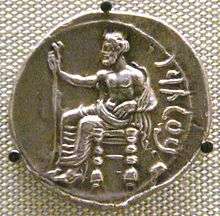Pharnabazus II

Pharnabazus II was a Persian soldier and statesman. He was the son of Pharnaces II of Phrygia and grandson of Pharnabazus I, and great-grandson of Artabazus I. He and his male ancestors had governed the satrapy of Hellespontine Phrygia from its headquarters at Dascylium since 478 BC. He married Apama, daughter of Artaxerxes II of Persia, and their son Artabazus was likewise a satrap of Phrygia.
According to research by Theodor Nöldeke, he was descended from Otanes, one of the associates of Darius in the murder of Smerdis.
Pharnabazus II is first recorded as satrap of this province in 413 BC, when, having received orders from Darius II of Persia to send in the outstanding tribute of the Greek cities on the Ionian coast, he, like Tissaphernes of Caria, entered into negotiations with Sparta and began a war with Athens. The conduct of the war was much hindered by the rivalry between the two satraps, of whom Pharnabazus was by far the more energetic and upright. Although Pharnabazus initially fought with the Spartans against the Athenians during the Peloponnesian war, even, in one instance, coming to the rescue of the retreating Spartan army, riding his horse into the sea to fend off the Athenians while encouraging his regiment.[1] However, he eventually came into conflict with the Spartan king, Agesilaus [2] and went on to aid the Athenians against the Spartans in the Corinthian War (395–387 BC). During this period, Pharnabazus is notable for his command of the Achaemenid fleet at the Battle of Cnidus in which the Persians, allied with the former Athenian admiral and then commissioned into Persian service, Conon, annihilated the Spartan fleet, ending their brief status as the dominant Greek naval power.[3] Pharnabazus followed up this victory by capturing several Spartan-allied cities in Ionia. Abydus and Sestus were the only cities to refuse to expel the Lacedaemonians despite threats from Pharnabazus to make war on them. He attempted to force these into submission by ravaging the surrounding territory, but this proved fruitless, leading him to leave Conon in charge of winning over the cities in the Hellespont. From there, Pharnabazus sailed with his fleet to the Aegean island of Melos and established a base there. He proceeded to take revenge on the Spartans by invading Lacedaemon, were he laid waste to Pherae and raided along the coast. Eventually he left due to scarce resources and few harbors for his fleet in the area, as well as the looming possibility of Lacedaemonian relief forces being dispatched. He then besieged and captured Cythera, proceeding to install an Athenian governor and a garrison to cripple Sparta's offensive military capabilities. He also gave Sparta's rivals funds to further threaten the Lacedaemonians. After being convinced by Conon that allowing him to rebuild the Long Walls around Piraeus, the main port of Athens, would be a major blow to the Lacedaemonians, Pharnabazus eagerly gave Conon a fleet and additional funds to accomplish this task. As a reward for his success, Pharnabazus was allowed to marry the king's daughter. He was then reassigned to help command a military expedition into Egypt, having proven his ability against the Spartans.[4][5]
References

